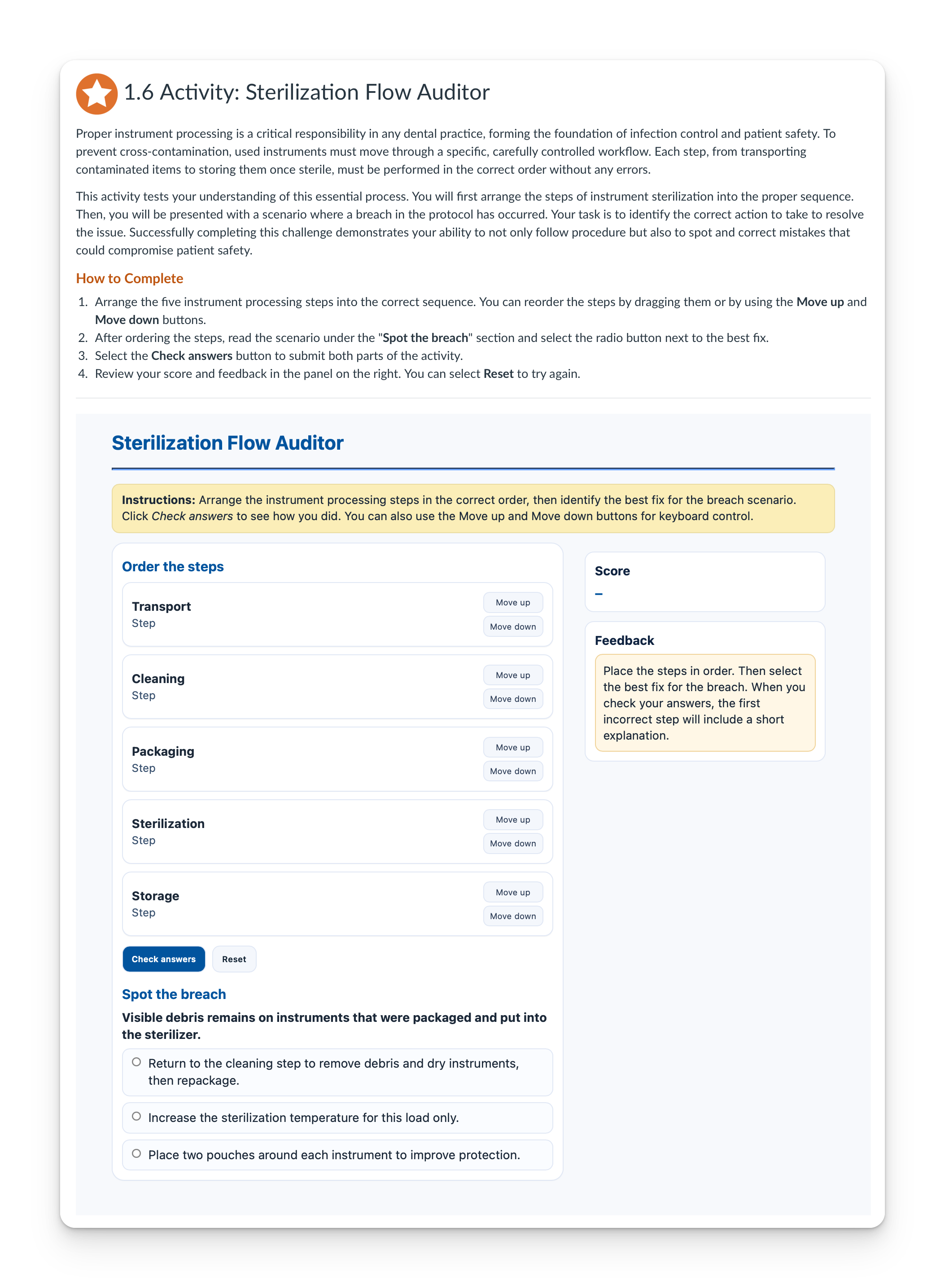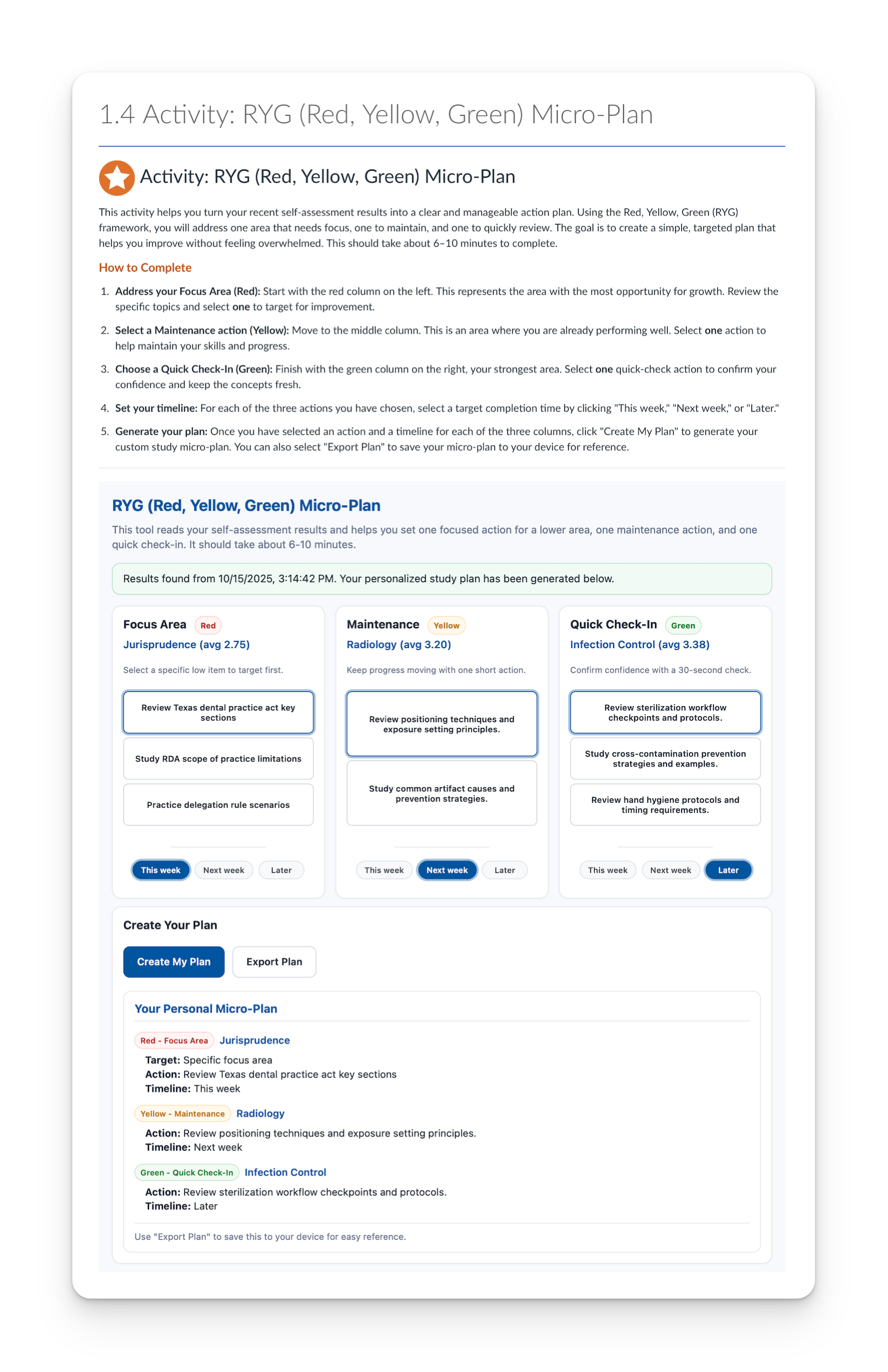Online Dental Assisting Program
Building accessible, engaging online learning experiences that prove LMS platforms can be beautiful and functional.
Building accessible, engaging online learning experiences that prove LMS platforms can be beautiful and functional.
A healthcare education institution needed a comprehensive online Dental Assisting program that could deliver professional-level education in a fully digital format. The challenge? Canvas LMS's default features weren't enough to create the engaging, interactive experience students deserved.
Online learners needing professional-quality education accessible from anywhere
Instructors requiring robust course delivery with easy content management
Institution maintaining accreditation standards and accessibility compliance
Instead of fighting Canvas's restrictions, I worked around them. Full web pages with custom HTML, CSS, and JavaScript are hosted on an external web server, then embedded into Canvas using iFrame containers configured with proper security headers and sizing. This architecture bypasses Canvas's JavaScript and CSS limitations while maintaining seamless integration. Students see it as native Canvas content.
The result? Professional-grade interactive components (flashcards with 3D animations, decision trees, practice quizzes with immediate feedback) living inside Canvas, delivering experiences far more sophisticated than typical LMS courses.




Built a reusable component library specifically optimized for Canvas iFrame embedding. Each module uses semantic HTML5 with custom CSS that respects Canvas's global styles while providing enhanced visual hierarchy and interactivity.
Every element was built with WCAG 2.1 AA compliance from the ground up. This includes proper ARIA labels, keyboard navigation, screen reader optimization, and color contrast ratios exceeding minimum standards.
Integrated video content with custom players, interactive image galleries, and embedded assessment tools. All multimedia includes captions, transcripts, and alternative text descriptions.
Responsive design ensuring perfect rendering across desktop, tablet, and mobile devices. Touch-optimized interactive elements and flexible layouts that adapt to any screen size.
One of the most powerful yet invisible features is client-side data persistence using browser localStorage. When students complete activities, their results and progress can be saved locally on their device and automatically imported into subsequent activities, creating seamless learning pathways without server-side complexity. This architecture enables sophisticated workflows where student inputs in one activity inform and personalize the next, all without requiring backend databases, API calls, or server-side processing. The data lives on the student's device, persists across sessions, and enables intelligent activity sequencing that adapts to individual learning needs.
For example: Students complete a self-assessment identifying knowledge gaps in dental terminology. Those results are saved locally and immediately appear in the next activity as a personalized micro-learning plan, targeting only the concepts they need to review. No manual data entry, no backend database, just intelligent workflow design using browser storage APIs.

Example of the self-assessment to micro-plan workflow: note the "results found" message indicating that data from a previous activity was successfully imported, allowing this activity to generate personalized study recommendations based on identified knowledge gaps
What makes this approach truly valuable is not just what it does for Dental Assisting, but what it enables for the future of online education at scale.
Because interactive components are hosted externally and embedded via iFrames, updates to any activity instantly propagate across all courses using that component. Fix a bug, improve an interaction, or add a feature once and every student in every course sees the improvement immediately. No republishing dozens of Canvas pages, no version control headaches, just instant deployment at institutional scale.
The component library built for Dental Assisting is not discipline-specific. Interactive flashcards, decision trees, practice quizzes, and multimedia demonstrations work equally well for nursing, medical coding, pharmacy tech, or any healthcare program. The same reusable components can serve multiple programs with only content changes, dramatically reducing development time for new courses.
Traditional LMS development is expensive because every course requires custom work. This approach inverts that model: build sophisticated components once, then deploy them across unlimited courses with minimal marginal cost. The initial investment in the component library and hosting infrastructure pays dividends as each new program leverages the same technical foundation.
The localStorage-based workflow currently handles simple self-assessment to micro-plan transitions, but the architecture supports far more sophisticated adaptive learning. Future iterations could track performance patterns across multiple activities, automatically adjust difficulty levels, identify prerequisite knowledge gaps, and generate personalized learning sequences without requiring backend machine learning infrastructure.
Because the interactive components are web-based and not locked into Canvas's proprietary format, they can be shared as open educational resources. Other institutions could embed the same externally-hosted activities into their LMS (Canvas, Blackboard, Moodle, D2L), democratizing access to high-quality interactive learning experiences across the entire educational landscape.
LMS platforms come and go, but web standards endure. By building on HTML5, CSS3, and vanilla JavaScript rather than Canvas-specific APIs, these interactive components will continue functioning regardless of future LMS migrations. The institution controls the hosting and can switch LMS platforms without rebuilding content from scratch.
The Strategic Vision: This is not just a Dental Assisting course. It is a proof of concept for how institutions can build their own high-quality interactive learning components that rival commercial products, while maintaining complete control over functionality, hosting, and intellectual property. The question is not what this approach can do for one course, but what it enables for an entire institution's online learning ecosystem.
Professional aesthetics that reflect the quality of a dental assisting program. Clean typography, intentional white space, and visual hierarchy guiding learner attention.
WCAG 2.1 AA compliant throughout. Screen reader compatible, keyboard navigable, with high contrast text and properly structured headings for assistive technologies.
Consistent experience whether students access on desktop, tablet, or phone. Content reflows intelligently, maintaining usability across all screen sizes.
Professional video integration with custom controls, interactive image galleries, embedded assessments, and multimedia demonstrations, all accessible and responsive.
Optimized assets and efficient code ensure quick loading even on slower connections. Lazy loading images and progressive enhancement for optimal performance.
Modular component architecture makes updates simple. Faculty can edit content without touching code, while maintaining consistent design and functionality.
WCAG 2.1 AA Accessibility Compliance
Student Satisfaction Rating
Increase in Mobile Access Compared to Previous Course
Interactive Learning Modules
Let's build accessible, engaging online learning experiences that your students will love.